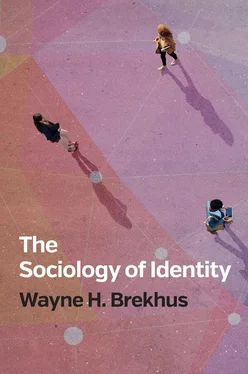These are all examples that illustrate the social nature and the importance of identity. Identity is a vital organizing element of social life. We use it to construct meaning, to classify, to articulate sameness and difference, to include and to exclude, to confer status and to assign stigma. Identity shapes how we categorize one another and how we interpret the world. We manage and construct our own identities and we are active in the construction and labeling of others’ identities. We construct identity at both the individual and the collective level. These examples also point to the three central themes related to identity that I mentioned at the beginning: authenticity, multidimensionality, and mobility.
The controversy over whether or not pop star Mahmood’s music qualifies as Italian revolves around competing definitions of what it takes for something to count toward an authentic national identity. Similarly, in the United States heated debates over where the “real America” lies center on contested definitions of authenticity. Self-identified Brits and self-identified Europeans have conflicting ideas about their identities as residents of the United Kingdom; and they, too, get into disputes over national identity and authenticity. Italians, residents of the United States, and residents of the United Kingdom alike have ideas about the authenticity of their and others’ claims to a national identity.
Questions of authenticity are complex, intersectional, and multidimensional. When California high school students choose their lipstick, they are not only concerned with belonging to their group of friends but relatedly interested in backing their claims to subcultural status through expressions of self and subcultural authenticity. By dressing so as to convey subcultural identity, high school girls simultaneously do race, class, gender, and sexuality. When Mahmood suggests that he is one hundred percent Italian, he constructs an Italian identity that is expressed through his ethnicity, his gender, and his sexuality and that combines his Italian and Egyptian parental lineages. His complex intersectional claim to Italian authenticity is challenged by politicians who demand a more restrictive, more “pure,” and less intersectional ethnic expression of Italian identity.
Identity is also mobile and fluid. What it means to be an Italian or an American is a shifting terrain, which influences individual claims to identity as well as perceptions of national identity. The contested definition of “real American” people and places occurs in a shifting demographic landscape wherein authenticity claims based on demographics from the 1950s are challenged partly on the basis of the empirical realities of the demographics of the 2020s. Just as national identities are fluid, individual identities, too, are mobile and changing.
These themes of authenticity, multidimensionality, and mobility will return throughout the book. Every theme will be discussed in separate chapters, but each one also relates to the others. People navigate authenticity by ordering their multidimensional aspects and by deploying multiple dimensions in a mobile fashion across space and time.
What exactly is identity? A precise definition of this term is hard to come by. No single formula adequately encompasses the range of ways in which the concept is used in the social sciences or in everyday life. Identity can be understood both as something that is relatively fixed and essential and as something malleable and fluid. It can be regarded as something deeply etched or as something that appears at the surface. The etymon of the term “identity” is the Latin pronoun idem, eadem, idem (“same”), which suggests that an important component of its meaning is a degree of sameness across a category that it conveys (see Jenkins 1996: 3; Lawler 2008: 2). At the same time identity also implies an individual’s uniqueness and difference from all others (Lawler 2008: 2). Tensions between sameness and difference illustrate the complexities of identity and require us to appreciate and understand the nuances in how identity is understood, assigned, claimed, enacted, and deployed. The contradiction between sameness and difference is often played out in identity–authenticity claims. When making claims of authenticity vis-à-vis an identity category, individuals often emphasize their similarity to other members of that category—ways in which they are, say, like other Italians, Texans, Christians, distance runners, alcoholics, vegetarians, gun owners, abuse survivors, or soldiers. Yet when they make claims of “self-authenticity” individuals often highlight their distinctiveness from others. In group identification, individuals often emphasize their similarities to other in-group members, while when it comes to self-identification they consider personal uniqueness a first priority.
One challenge to the study of identity is that the term is used in a wide variety of ways by different scholars. Many scholars take a personal and individual approach, looking at personal identity or self-identity as the feature that individually differentiates one person from others. Other scholars are interested primarily in social identity and the ways in which individuals internalize collective categorial identifications (see Jenkins 2014: 114). And still others who are interested in collective categorial identifications want to understand not only how individuals internalize them but how collectives and non-individual social forms such as nations, schools, neighborhoods, and organizations also have their own collective identities . To understand identity it is thus important to recognize that it can refer to self-identity, to social identity, or to collective identity. Although analysts separate these different forms of identity to demonstrate the multiple layers of the concept, such forms are often intertwined in everyday life. That is, collective and social identities influence personal identity and, likewise, personal and social identifications factor into collective identities.
In arguing against the concept of identity, Brubaker and Cooper (2000) make the point that the term has multiple meanings. Identity, they argue, is a concept distinct from interest. Interests are instrumental and have a clear goal, while actions related to identity have meaning-oriented rather than instrumental goals. Identity, in one reading, designates how action—individual or collective—is governed by particular self-understandings rather than by universal self-interest (Brubaker and Cooper 2000: 6). When understood as a collective phenomenon, it indicates an important sameness among members of a social category; when understood as a product of social or political action, it sheds light on the interactive development of the kinds of collective identifications and self-understandings that make identity politics and collective political action possible. For Brubaker and Cooper, the sheer number of uses of the concept of identity makes it analytically fragmented and unusable as a concept. They assert, for example, that, “if one wants to argue that particularistic self-understandings shape social and political action in a non-instrumental manner, one can simply say so … If one wants to examine the meanings and significance people give to constructs such as ‘race,’ ‘ethnicity,’ and ‘nationality … it is not clear what one gains by aggregating them under the flattening rubric of identity” (Brubaker and Cooper 2000: 6). Brubaker and Cooper point to the widely different, and sometimes diverging, uses of identity and assert that this variety makes the concept unusable.
According to the two authors, combining race, ethnicity, nationality, and other social constructions under the single rubric of identity brings little gain. This provocative statement is important—not because it precludes the study of identity, but rather because it requires us to be explicit about the analytic benefits of a unifying rubric such as identity. There is in fact much to be gained by studying such different collective identifications as race, ethnicity, nationality, gender, sexuality, and subculture for their analytic similarities and to look at self-identity, collective identity, and the identity of non-individual forms searching for parallel processes of identity construction and identity marking and unmarking. Here, rather than seeing race, ethnicity, nationality, gender, sexuality, subculture, and other constructs as too dissimilar to be studied together, we can acknowledge their substantive differences while still valuing their formal, general analytic similarities. The ways in which people navigate social constructs to organize their selfdefinitions, to generalize about others, and to participate in the boundary politics of inclusion and exclusion are worth studying not only in their separate, individual substantive areas or in their separate and specific uses (e.g. personal identification, collective mobilization), but for analytic similarities and tensions between them across domains and uses.
Читать дальше












